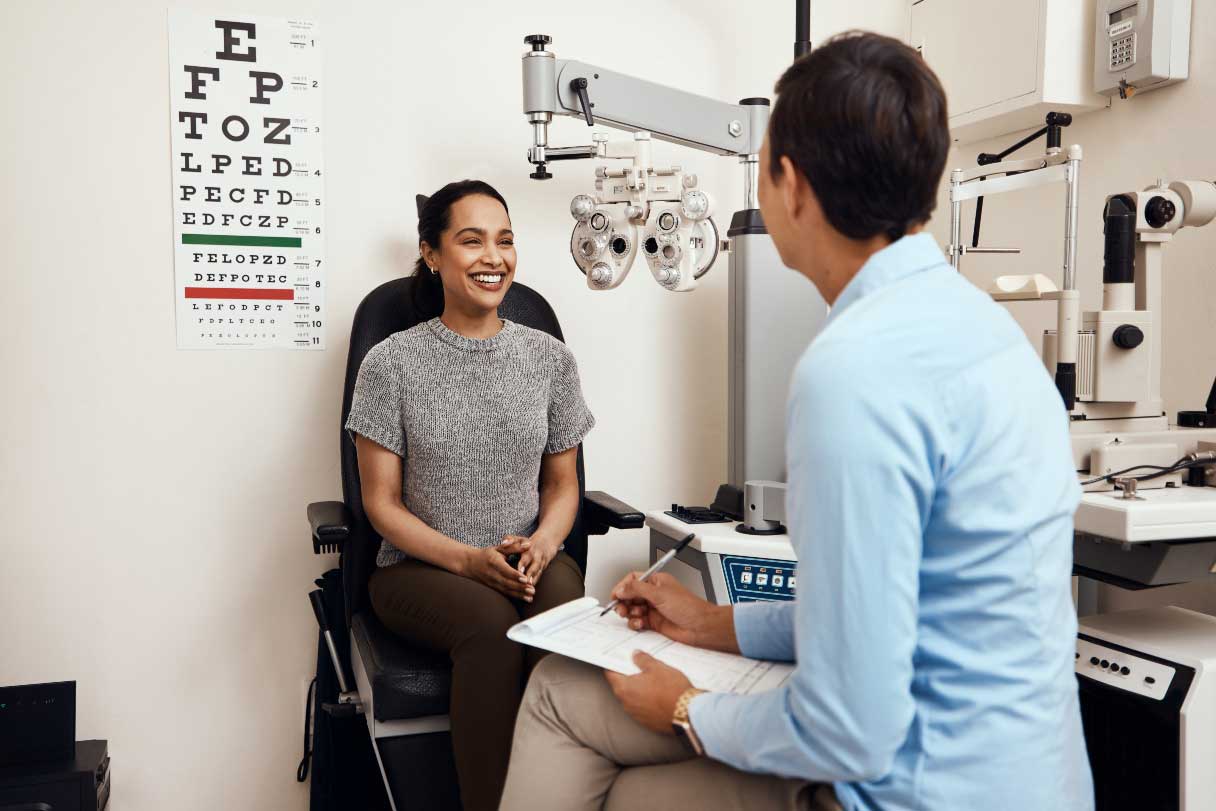When it comes to buying glasses or contacts, there are seemingly endless options. From your local optometrist's office to discount stores and online retailers, it can be difficult to weed through the choices and decide where you can get the best deal and best fit for your needs.
Below, we'll review in-person and online options to help you decide where to purchase your next set of eyewear, and where you can use your CareCredit credit card.
Start With an Eye Exam
Regular eye exams are not just vital for making sure you have the most accurate glasses or contacts prescription,1 but are essential for overall eye health. Optometrists (ODs) screen for diseases including glaucoma, cataracts, macular degeneration, hypertensive retinopathy and diabetic retinopathy (diabetes is the number one cause of blindness in adults under the age of 65).2 Many of these diseases are treatable if found early. Some optometrists can also prescribe medications to treat conditions like red eye, conjunctivitis and even glaucoma.2
ODs are also trained to identify concerns around visual processing, strabismus (misaligned or "crossed" eyes), nystagmus (uncontrollable eye movements) and irregular depths of field, and are integral in helping slow the progression of myopia (nearsightedness) in children caused by axial elongation.3
Checking your eyes regularly is as important as your routine dental care, and while there are now online tools that can help determine your prescription from an existing pair of glasses, you'll need to visit an optometrist to get your first — and subsequently, most up-to-date — prescription.
How long is an eye exam?
Whether you go to a dedicated eye care office or an optometrist who works out of a store like Walgreens or Walmart, an eye exam takes about 45 to 90 minutes.1 The doctor will ask about your medical history and do some tests to check both your vision and the overall health of your eyes.1 This ensures an accurate prescription and helps catch any issues, like astigmatism or cataracts.4
Using your prescription
Once you get your prescription, the optometrist can help you find the right size frame, select lenses and coatings and make any adjustments you might need after your frames come in.4
When you order contacts from an optometrist, you may be able to exchange your unused lenses if your prescription changes. Optometrists may also have special rebates for their customers that make contacts more affordable.5
Buying Glasses or Contacts From Your Optometrist
Purchasing from your trusted independent optometry practice is a convenient way to access a range of eyewear, including premium frames and lenses. The continuity of care is strong — your optometrist can often help recommend the best products for your needs and help you manage your contact lenses or glasses over time. On the other hand, larger chain stores may offer more competitive pricing and faster turnaround times. The best option for you depends on your individual needs.
Average cost
Depending on the frames, lenses and coatings, the cost of glasses and contacts has several variables:6
- Standard glasses: $50 to $1,000
- Name brand frames: $1,000+
- With insurance: $196 (on average)
- Insurance copays: $0 to $50
- Contacts: $185 to $1,000 per year for both eyes7
Buying Glasses or Contacts From an Online Retailer
Before you can purchase online, you'll need a current prescription from an optometrist that you can use to order your glasses or contacts.8
Many online stores have virtual try-ons so you can see how the frames fit your face before you buy. Others allow you to choose multiple frames to try on at home before deciding which pair you want.
The benefits of buying glasses online are similar to shopping online for anything else: a better selection, it saves you time and you can shop around on several sites to find the best deal.8
Online shopping is a great option for simple, monofocal prescriptions with no abnormalities (you may not be able to purchase specialized prescriptions online at all). It can be quite affordable, convenient and offer a large selection, but they come at the cost of more accurate fittings and adjustments, and may not last as long as the pair you purchase from your optometrist. Last but not least, if you plan to use insurance to purchase your glasses or contact lenses, make sure your provider covers the online retailer you choose.8
Average cost
The cost of lenses online varies widely depending on your insurance, your prescription and what style of frames you choose. Expect to pay anywhere from $8 to $1,000.8
Contacts may be a little cheaper online, but still typically cost between $185 and $1,000 per year for both eyes, depending on the type of lenses you need.7
Best Places to Buy Glasses or Contacts With CareCredit
Whether you're looking for your next pair of glasses or set of contacts from an optometrist or online, CareCredit retailer partners nationwide accept the CareCredit credit card. You can also use your CareCredit credit card at large retailers, including:
- Duane Reade
- Walgreens
- Walmart
- Sam's Club
Retailers Where You May Want to Use CareCredit to Buy Glasses Online
You can use your CareCredit credit card at large retailers including America's Best®, Visionworks®, LensCrafters®, Pearle Vision™, and For Eyes®. If your favorite retailer doesn't currently accept CareCredit, we are always building new partnerships, so check our retailer partners near you often.
Financing Eyewear With the CareCredit Credit Card
Whether you're purchasing new frames, getting contacts or due for an eye exam, the CareCredit credit card can help you pay for care where your insurance leaves off.* Use our Acceptance Locator to find a vision specialist near you that accepts CareCredit so you can see all that life has to offer. Continue your wellness journey by downloading the CareCredit Mobile App to manage your account, find a provider on the go and easily access the Well U blog for more great articles, podcasts and videos.
In addition to vision care, you can also use your CareCredit credit card for dentistry, cosmetic, pet care, hearing, health systems, dermatology, pharmacy purchases, spa treatments and so much more within the CareCredit network. How will you invest in your health and wellness next?
Author Bio
Abbie Mood is a freelance writer with more than 10 years of experience. She has worked with clients of all sizes to create compelling content and she has written for the American Kennel Club, Marriott Bonvoy, Women's Health Online, Headspace and more.







